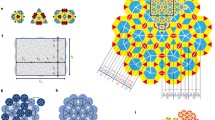Abstract
One of the fundamental problems of quasicrystals is to understand their occurrence in microscopic models of interacting particles. We review here recent attempts to construct stable quasicrystalline phases. In particular, we compare two recently constructed classical lattice-gas models with translation-invariant interactions and without periodic ground-state configurations. The models are based on nonperiodic tilings of the plane by square-like tiles. In the first model, all interactions can be minimized simultaneously. The second model is frustrated; its nonperiodic ground state can arise only by the minimization of the energy of competing interactions. We put forward some hypotheses concerning stabilities of nonperiodic ground states. In particular, we introduce two criteria, the so-called strict boundary conditions, and prove their equivalence to the zero-temperature stability of ground states against small perturbations of potentials of interacting particles. We discuss the relevance of these conditions for the low-temperature stability, i.e., for the existence of thermodynamically stable nonperiodic equilibrium states.
Similar content being viewed by others
REFERENCES
D. Schechtman, I. Blech, D. Gratias, and J. W. Cahn, Metallic phase with long-range orientational order and no translational symmetry, Phys. Rev. Lett. 53:1951 (1984).
C. L. Henley, Random tiling models, in Quasicrystals: The State of the Art, P. J. Steinhardt and D. P. DiVincenzo, eds. (World Scientific, Singapore, 1992).
R. M. Robinson, Undecidability and nonperiodicity for tilings of the plane, Invent. Math. 12:177 (1971).
B. Grünbaum and G. C. Shephard, Tilings and Patterns (Freeman, New York, 1986).
R. Penrose, The role of aesthetics in pure and applied mathematical research, Bull. Inst. Math. Applications 10:266 (1974).
C. Radin, Tiling, periodicity, and crystals, J. Math. Phys. 26:1342 (1985).
C. Radin, Crystals and quasicrystals: a lattice gas model, Phys. Lett. A 114:381 (1986).
J. Miekisz and C. Radin, The unstable chemical structure of the quasicrystalline alloys, Phys. Lett. A 119:133 (1986).
J. Miekisz, Many phases in systems without periodic ground states, Commun. Math. Phys. 107:577 (1986).
C. Radin, Low temperature and the origin of crystalline symmetry, Int. J. Mod. Phys. B 1:L157 (1987).
J. Miekisz, Classical lattice gas model with a unique nondegenerate but unstable periodic ground state configuration, Commun. Math. Phys. 111:533 (1987).
J. Miekisz, A microscopic model with quasicrystalline properties, J. Stat. Phys. 58:1137 (1990).
C. Radin, Disordered ground states of classical lattice models, Rev. Math. Phys. 3:125 (1991).
J. Mieisz, A global minimum of energy is not always a sum of local minima—a note on frustration, J. Stat. Phys. 71:425 (1993).
J. Miekisz, Quasicrystals—Microscopic Models of Nonperiodic Structures (Leuven Lecture Notes in Mathematical and Theoretical Physics, Vol. 5, Leuven University Press, 1993).
J. Mieekisz, Stable quasicrystalline ground states, J. Stat. Phys. 88:691 (1997).
J. Miekisz, An ultimate frustration in classical lattice-gas models, J. Stat. Phys. 90:285 (1998).
J. Hubbard, Generalized Wigner lattices in one-dimension and some applications to tetracyanoquinodimethane (TCNQ) salts, Phys. Rev. B 17:494 (1978).
P. Bak and R. Bruinsma, One-dimensional Ising model and the complete devil's staircase, Phys. Rev. Lett. 49:249 (1982).
S. Aubry, Exact models with a complete devil's staircase, J. Phys. C 16:2497 (1983).
H.-C. Jeong and P. J. Steinhardt, Cluster approach for quasicrystals, Phys. Rev. Lett. 73:1943 (1994).
P. J. Steinhardt and H.-C. Jeong, A simpler approach to Penrose tiling with implications for quasicrystal formation, Nature 387:431 (1996).
H.-C. Jeong and P. J. Steinhardt, Constructing Penrose-like tilings from a single prototile and the implications for quasicrystals, Phys. Rev. B 55:3520 (1997).
F. Gähler and H.-C. Jeong, Quasicrystalline ground states without matching rules, J. Phys. A: Math. Gen. 28:1807 (1995).
K. Gawedzki, R. Kotecký, and A. Kupiainen, Coarse-graining approach to first-order phase transitions, J. Stat. Phys. 47:701 (1987).
S. A. Pirogov and Y. G. Sinair, Phase diagrams of classical lattice systems I, Theor. Math. Phys. 25:1185 (1975).
S. A. Pirogov and Y. G. Sinai, Phase diagrams of classical lattice systems II, Theor. Math. Phys. 26:39 (1976).
Y. G. Sinai, Theory of Phase Transitions: Rigorous Results (Pergamon, Oxford, 1982).
F. Koukiou, D. Petritis, and M. Zahradník, Low temperature phase transitions on quasiperiodic lattices, in Cellular Automata and Cooperative Systems, Proceedings of the NATO Advanced Institute, Les Houches, France, June 22–July 2, 1992 (Dordrecht, Kluwer Academic Publishers, 1993).
P. A. Kalugin, Phason disorder in 2D quasicrystals, JETP Lett. 49 (1989).
K. J. Strandburg and P. R. Dressel, Thermodynamic behavior of a Penrose-tiling quasicrystal, Phys. Rev. B 41:2469 (1990).
L. H. Tang and M. V. Jarić, Equilibrium quasicrystal phase of a Penrose tiling model, Phys. Rev. B 41:4524 (1990).
H.-C. Jeong and P. J. Steinhardt, Finite temperature elasticity phase transition in decagonal quasicrystals, Phys. Rev. B 48:9394 (1993).
T. Dotera and P. J. Steinhardt, Ising-like transition and phason unlocking in icosahedral quasicrystals, Phys. Rev. Lett. 72:1670 (1994).
A. C. D. van Enter and J. Miekisz, Breaking of periodicity at positive temperatures, Commun. Math. Phys. 134:647 (1990).
A. C. D. van Enter and B Zegarliński, Non-periodic long-range order for one-dimensional pair interactions, J. Phys. A: Math. Gen. 30:501 (1997).
A. C. D. van Enter, J. Miekisz, and M. Zahradník, Nonperiodic long-range order for fast-decaying interactions at positive temperatures, J. Stat. Phys. 90:1441 (1998).
R. L. Dobrushin and S. B. Shlosman, The problem of translation invariance of Gibbs states at low temperatures, Sov. Sci. Rev. C 5:53 (1985).
M. Aizenman, Translation invariance and instability of phase coexistence in the two-dimensional Ising model, Common. Math. Phys. 73:83 (1980).
Y. Higuchi, On the absence of non-translation-invariant Gibbs states for the two-dimensional Ising model, in Random Fields (Coll. Math. Soc. J. Bolyai, No. 27), Fritz, Lebowitz, Szasz, eds. (1981).
J. Slawny, Low temperature properties of classical lattice systems: Phase transitions and phase diagrams, in Phase Transitions and Critical Phenomena, C. Domb and J. L. Lebowitz, eds. (Academic Press, London, 1987), Vol. 11.
Author information
Authors and Affiliations
Rights and permissions
About this article
Cite this article
Mi¸ekisz, J. Classical Lattice-Gas Models of Quasicrystals. Journal of Statistical Physics 95, 835–850 (1999). https://doi.org/10.1023/A:1004542115011
Issue Date:
DOI: https://doi.org/10.1023/A:1004542115011



